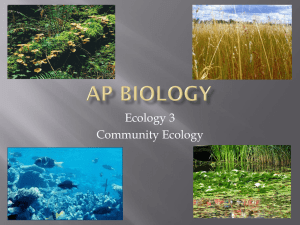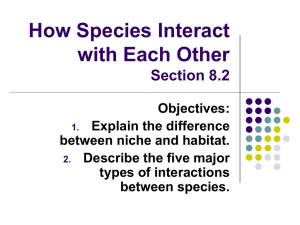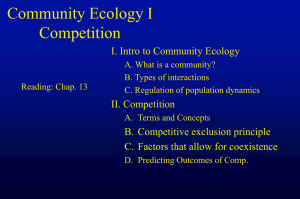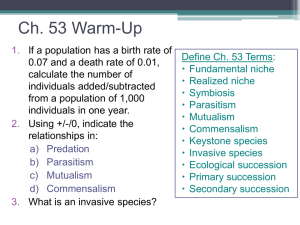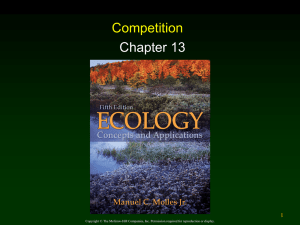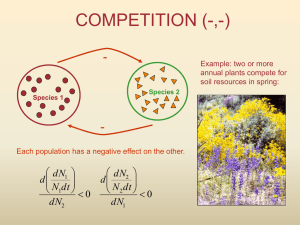PowerPoint - Susan Schwinning
advertisement
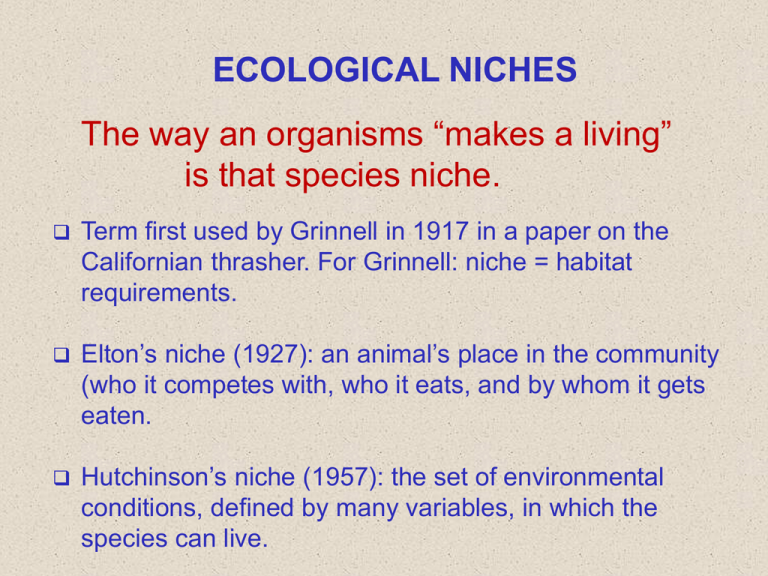
ECOLOGICAL NICHES The way an organisms “makes a living” is that species niche. Term first used by Grinnell in 1917 in a paper on the Californian thrasher. For Grinnell: niche = habitat requirements. Elton’s niche (1927): an animal’s place in the community (who it competes with, who it eats, and by whom it gets eaten. Hutchinson’s niche (1957): the set of environmental conditions, defined by many variables, in which the species can live. Elton’s niche: a place in the food web: Elton’s niche: a place in the food web: Hutchinson’s niche: the total set of all physical conditions in which a species can be found. Extend to “hypervolume” for many factors Hutchinson’s niches get smaller when other species are present: Humidity Spc B by itself A B Temperature Temperature Spc A and B together Humidity Humidity Spc A by itself B A Temperature ECOLOGICAL NICHES Fundamental niche: the full range of conditions under which an organism can exist. Realized niche: the portion of the fundamental niche occupied in the presence of other species. For all niches: we recognize them only if at least one species takes them. WHAT IS SO IMPORTANT ABOUT NICHES? Because the niche may explain what it takes for a species to exist in a place, niche theory can potentially answer many fundamental questions: How can so many species stably coexist? How does a niche come into being? Are all niches occupied? Is there any upper limit to how many niches (thus species) there can be? How many times can the total available energy (sunlight) be subdivided to support another species? Environmental Temperature EXAMPLES Fundamental and realized niches in space and time. What happens to a vacant niche? Does high diversity prevent invasion by a new species? Two species of barnacle Chthamalus Balanus The two species live in different sections of rock: Desiccation tolerance limits here Predation tolerance limits here The two species fundamental niche is where each organism can settle and thrive in the absence of the other: Here Balanus outcompetes Chthalamus Here Chthalamus outcompetes Balanus growth rate Balanus larvae settle Chthamalus larvae settle low middle Location in intertidal zone high Balanus alone Balanus fundamental niche growth rate Chthamalus alone Chthamalus fundamental niche low middle Balanus realized niche growth rate high Balanus and Chthamalus together Chthamalus realized niche low middle high Location in intertidal zone Coyote (10 – 25 kg) Food: sheep, poultry, mice, rabbits, ground squirrels, other small rodents, insects, reptiles, fruits and berries. Red fox (4 – 8 kg) Food: mice, voles, woodchucks, rabbits, chipmunks, fruits, insects, birds and eggs, carrion, garbage, amphibians, and reptiles. Fundamental Niche Relative food use Coyote Red Fox insects birds rodents rabbits Food item size young livestock Realized Niche Relative food use Coyote Red Fox insects birds rodents rabbits Food item size young livestock Animals trapped as a function of time Diverse community of tropical rodents in Mexico Castro-Arellano & Lacher 2009 Some ants forage at different times. If ants forage at the same times, often not in the same place. 10:30 Vacant niches: Fish gills have many parasites. Numbers vary from 0 to 30. Fish populations can have up to 30 species of parasites, but most of the time they have far fewer. This indicates a missed ecological opportunity, or empty niches. Vacant niches, implications: If every environment or community has many vacant niches, many more species could share the available resources. Thus, it should often be possible to introduce new species without losing resident ones. Humans have either intentionally of unintentionally introduced many species with mixed results. • naturalization: species gets added to the local species pool, adding to local diversity. • Invasion: new species take over, replacing many species of the local species pool, diversity declines. Some introductions from Europe: Some other introductions: Invasive species in the habitat of origin are harmless: Invasiveness and invasibility: What makes some species more aggressive in the new habitat? Noxious invaders often have the following characteristics: • • • • • Sexual & asexual reproduction Rapid reproduction High dispersal Phenotypic plasticity Tolerance for environmental conditions (generalist) Lack of natural enemies in the new environment Lack of co-evolution with native competitors What makes a habitat more invasible than others? Disturbance of the native community Recent history of ecosystem (generalist) Low native diversity More diverse communities often accommodate more exotic species, however, exotic species may be less invasive in diverse communities. Plant species in Australian heath and shrublands From Levine and D’Anotonio 2000 In controlled experiments, invasive species are indeed less successful invading high-diversity plots. Digitaria ischaemum (weedy C4 grass) and Crepis tectorum (weedy composite) in Minnesota grassland plots: Naeem et al. 2000 Summary: 1) The niche concept has been around for 100 years and has had many different interpretations and applications. 2) Ultimately, niches do not explain species diversity (because the species makes the niche, not the niche the species), but the concept still makes us ask good scientific questions: • What does a species need to persist? • How is a species range/activity affected by the presence of other species? • What makes a community vulnerable to invasion? • What makes a species a “hostile” or “benign” invader?
